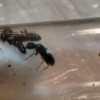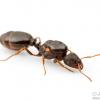I caught a formica queen a few weeks ago. She layed 11 eggs within a few days.
I checked on them about once a week, to see the changes they made. 9 eggs went to larva stage pretty fast, and then the pupa stage in a cacoon. I'm not sure how many days excatly.
2 of the eggs seemed to mature allot slower. They were barely through there larval stage by the time all the others were already wrapped. The other night I checked on them expecting to see cacoons. Instead they seemed like they bypassed the cacoon spining stage. They went from looking like a maggot to a worker shape nearly over night it seemed.
I know some species don't spin cacoons. I always thought it was one or the other. Does anyone know if this is common.
She had no eggs when I caught her. I can only think that maybe the queen didn't have enough fat reserves to give the larve enough nutrients. She doesn't seemed malnoutished. And I gave her a drop of honey that she did eat the day I caught her.
- Formiculture.com
- Forums
- Gallery
- Members
- Member Map
- Chat















